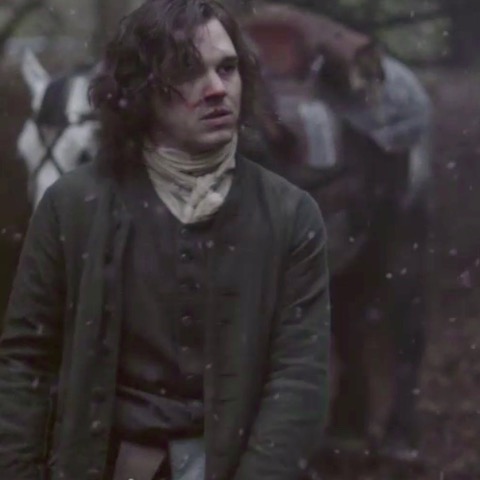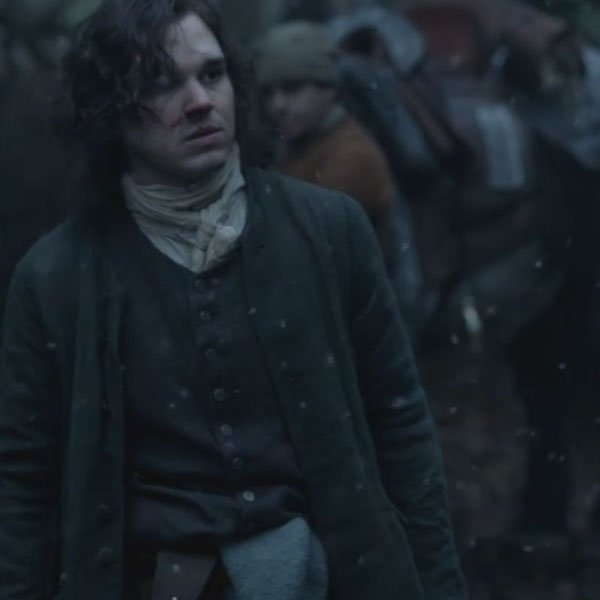Welcome budding anatomists to my 2016 Scotland Outlander tour, Part 2 (here is Part 1). As before, Starz images and book quotes are sprinkled amid the travelogue. A few spoilers from Diana’s books are included but I will alert you to major ones so you can skip if need be. Just look for this book kitteh…that’s your major spoiler cue (there are minor ones too).
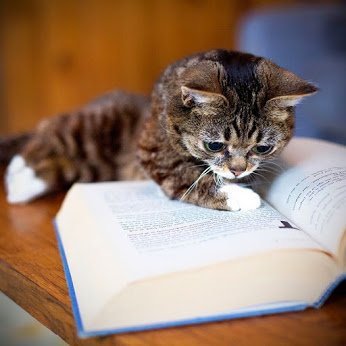
Let’s get right to it!
Returning to my travel saga, we visited a memorial (Photo A) in the form of a massive cairn honoring The Black Watch, a.k.a. The Highland Watch or The Watch. The monument is topped with a statue of Private Farquhar Shaw dressed in the original uniform of the Black Watch Regiment.
The Watch was originally commissioned in 1667 by King Charles II who authorized clan chiefs to raise independent companies “to be a constant guard for securing the peace in the Highlands” and to “watch upon the braes.” Members of the Watch wore dark tartans to distinguish them from the redcoats and thus became known the “Freiceadan Dubh” or “The Black Watch.”
Later, The Watch morphed into the 42nd Royal Highlander, a foot company that fought with valor in many conflicts including Culloden, Fort Ticonderoga, Napoleonic Wars, and Waterloo!
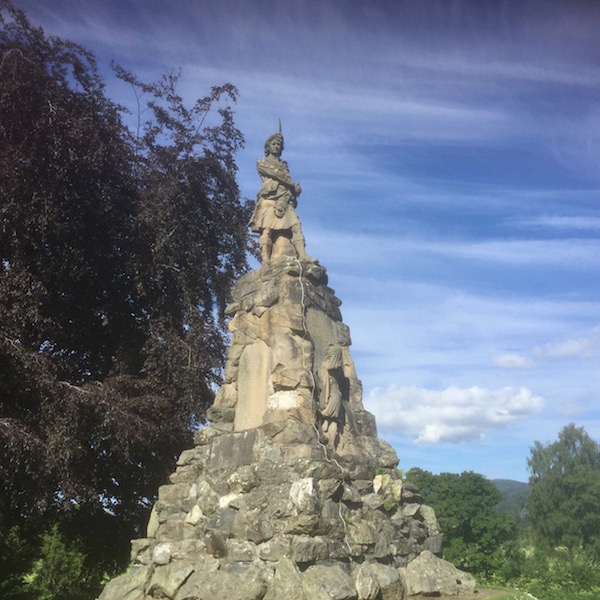
Photo A
You recall The Watch, right? We first met them burning a cottage and stealing goods and chickens from suspected redcoat sympathizers (Starz episode 105, Rent).

BOOK SPOILER: This reference to The Watch does not appear in Outlander episodes. The next quote comes from Outlander book; skip if you do not want to read it:
“It’s the Watch,” he said, nodding back in the direction of the inn. “We’re safe enough, but I thought we’d as soon be a bit further away.” I had heard of the famous Black Watch, that informal police force that kept order in the Highlands, and heard also that there were other Watches, each patrolling its own area, collecting “subscriptions” from clients for the safeguarding of cattle and property.
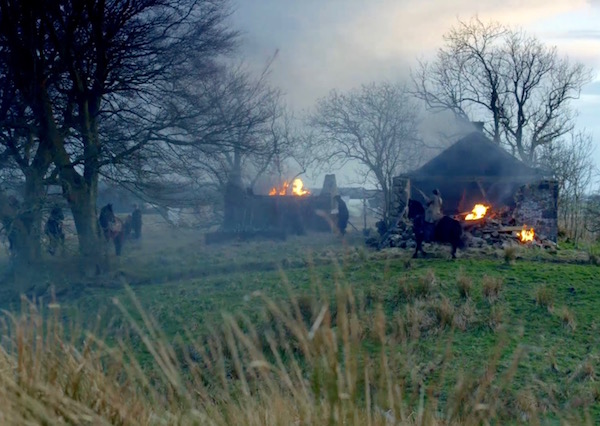
The Watch briefly re-emerges at the end of Starz, episode 112, Lallybroch, as leader Taran MacQuarrie holds a pistol to Jamie’s head. They’re baaaack! Taran, don’t you dare shoot our beloved lad!
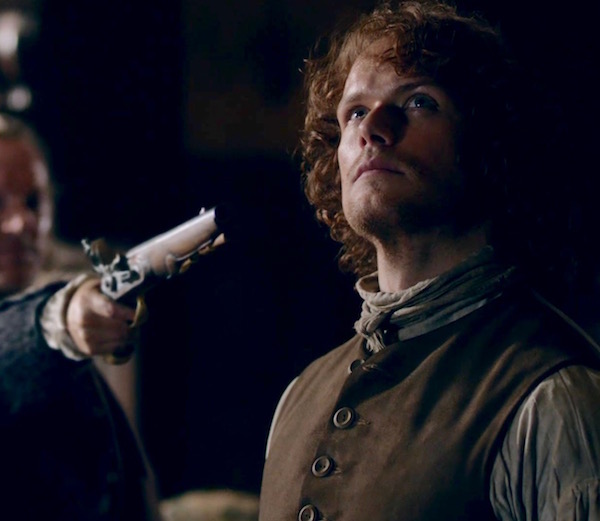
You may also recall that in Starz episode 113, The Watch, Jamie joins Taran and his men on a raid. Instead, horrible Horrocks set up an ambush where Jamie and MacQuarrie are taken prisoner by the redcoats.

BOOK SPOILER! Starz episodes 112 and 113 deviate in the depiction of The Watch as presented in the books. Skip these next sentences and two quotes if you don’t want to know the alternative reality!
In Outlander book, Jamie is betrayed by his own tenant, Ronald MacNab. The Watch takes Jamie prisoner and turns him over to the redcoats to collect the price on his head. This is how he ends up in BJR’s beastly grasp! Ian explains to Claire and Jenny:
“Jamie,” he gasped. “We met the Watch near the mill. Waiting for us. They knew we were coming.” My stomach lurched. “Is he alive?” He nodded, panting for breath. “Aye. Not wounded, either. They took him to the west, toward Killin.
Claire reflects back on that terrifying moment in this excerpt from Diana’s second book, Dragonfly in Amber:
The hair prickled on the back of my neck, despite the heat of the day. Ronald MacNab was the tenant who had betrayed Jamie to the men of the Watch a year before, the man who had died for his treachery within a day of its being found out.
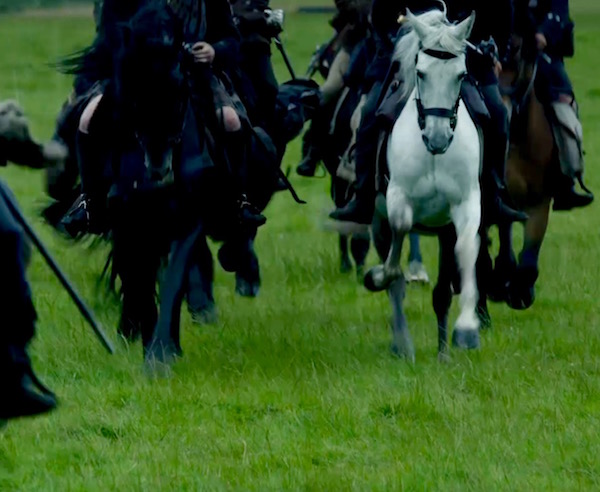
Near The Watch monument stands the impressive “General Wade’s Bridge” as it crosses the River Tay (Photo B). An architectural work of art, this stone bridge was built in 1733 by General Wade as part of some 40 bridges and 250 miles of new roads across the Highlands in the aftermath of the 1715 Jacobite uprising. It sports arches, parapets, and obelisks and, given the era, was very expensive to build (over £4,000). The bridges and roads were designed for military purposes to provide improved routes between Highlands and Lowlands, and ensure that government troops could move quickly to suppress any future Jacobite rebellions. Ironically, the new roads were of most use to Bonnie Prince Charlie during the 1745 Jacobite uprising – at least at first.
SORT OF SPOILER! Ever the historian, Diana mentions General Wade’s historic efforts in her fourth book, The drums of Autumn. You might skip the next quote if you haven’t read the book. No spoilers as to who are the “he” and the “she” of the quote!
He had carried her through the summer-green glens and rock-lined gorges without a slip, taking her higher and higher along the good roads made by the English general Wade fifty years before, and the bad roads beyond the General’s reach, splashing through brushy burns and climbing up to the places where the roads dwindled away to nothing more than a red deer’s track across the moor.
The incredible Wade bridge was designed by Scottish architect, William Adam, and some 300 years later, is still used by today’s traffic despite it being designed to bear lighter loads; we drove over it. The bridge was also build mostly by Scots laborers. Pretty amazing engineering feat. Way to go, lads!
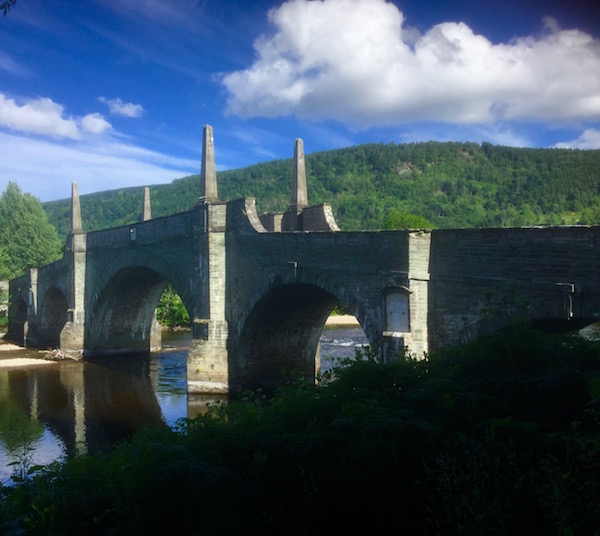
Photo B
Clearly not the same bridge but of similar design, Dougal’s rent party rides over a stone arched bridge near Castle Leoch (Starz episode 109, The Reckoning). Yep, Jamie feels very uneasy after giving Claire a good hiding for not staying put. He thought a sword belt would giver her a clearer understanding of the meaning of keeping hid. But, as a newly minted hubby, he had precious little experience with a wife, especially one as spirited as Claire! Ye misjudged the fallout over that one, Jamie. Only a dirk at your throat and some major TLC is gonna settle that trauma drama! Man up, lad!
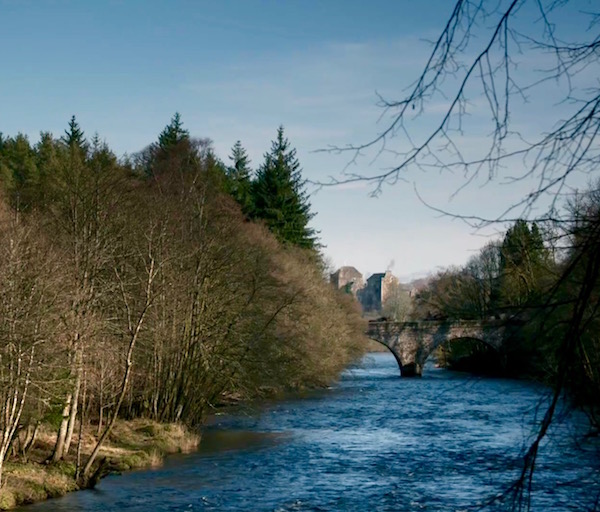
We motored the same day to beautiful Loch Rannoch, a large east-to-west oriented lake of the highlands (Photo C). Not just another pretty face, it also features in a Starz Outlander episode.
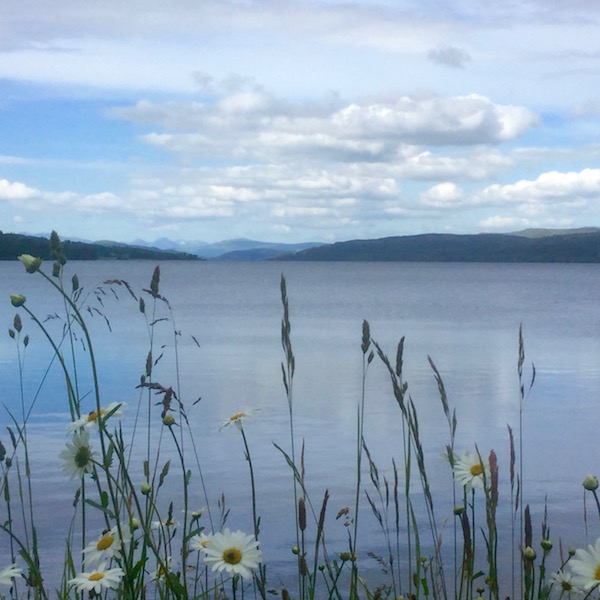
Photo C
On the bonny banks of this Loch (Starz episode 105, Rent), Claire and Ned quote verses by the English poet, John Donne (1572-1631):
ABSENCE, hear thou my protestation
Against thy strength,
Distance, and length;
Do what thou canst for alteration:
For hearts of truest mettle
Absence doth join, and Time doth settle.
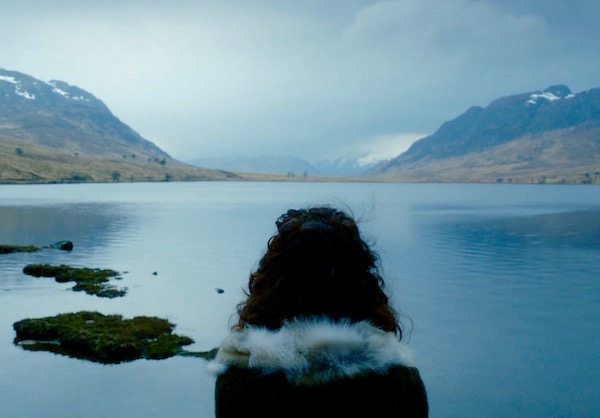
Their pastoral poetry recitation is cut short by Dougal’s men encouraging innocent Willie (we miss ye lad!) to engage in Biblical relations with his sister! What? Claire is a bit weirded out by that one but Ned explains: this is Willie’s first time on the road and he sits at the bottom of the pack!
On the bonny banks of this Loch, Claire treats a hacking Ned Gowan – she would have him smoke a pipe for a cough? Well, the pipe contains thornapple (Jimson weed), an herbal treatment for asthma. It helps. Yay, nurse Claire strikes again!
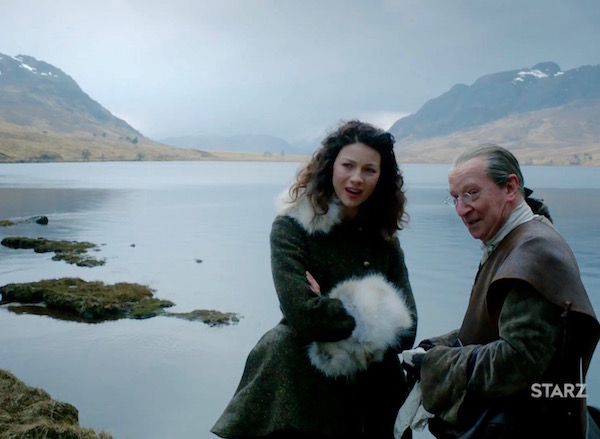
Our next stop was an 18th century thatched village at The Highland Folk Museum, a large open air preserve of ancient buildings designed to demonstrate life of an earlier Scotland. The museum sits on 80 acres of lush, green land surrounded by the Cairngorm mountains. The village itself is a cluster of various cottages and a stable – peaceful and quiet, radiating the texture of a by-gone era (Photo D).
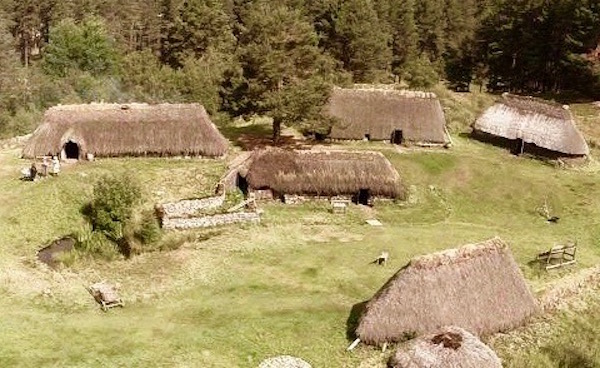
Photo D
Based on an ancient settlement (Badenoch of Easter Riatts), the buildings were recreated as accurately as possible. Thatched roofs, structural timbers, stone foundations, and turf and stone walls gave the feeling that we, too, had travelled back through the stones (Photo E). But, the most thrilling fact about this historical settlement: Outlander used the village (2014) to film scenes for Starz episode 105, Rent.
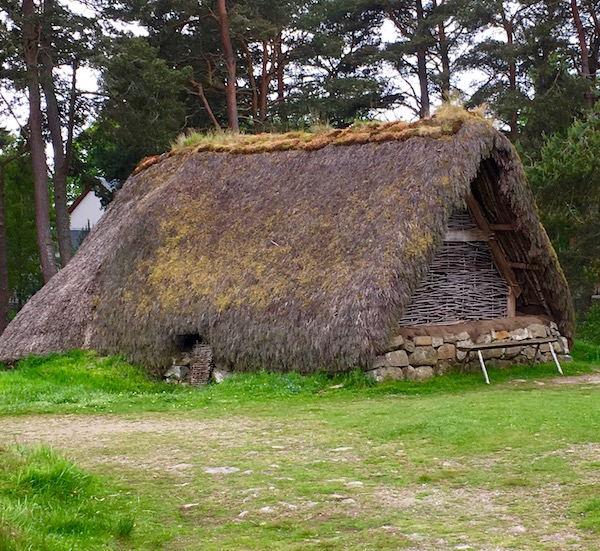
Photo E
Stepping into the central green, I was able to get a full view of this large cottage and the central green. Ancient wooden tools stand on display (Photo F). Love the mossy stone walls and the wooden crib in the foreground!
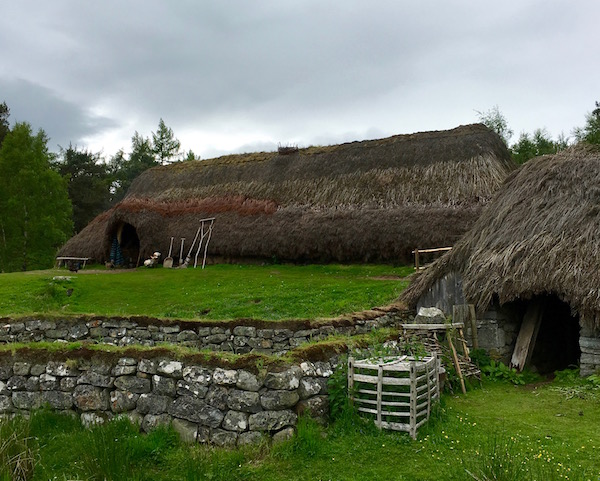
Photo F
Moving closer, the cottage features a stone foundation, sod walls, and thatched roof (Photo G) typical of crofter’s or cottar’s abodes. Thatching in the Highlands did not use water reed (common in Lowlands and England) but rather employed one of the following materials:
- Fraoch – heather
- Luachair – soft rush
- Muran – marram grass
- Bun dubh raineach – black foot of bracken
- Oat straw
- Bealaidh – Scotch broom (Abundant in my neck of the woods!)
Thatch had to be renewed and repaired fairly often although some materials (heather) were more durable than others (Scotch broom).
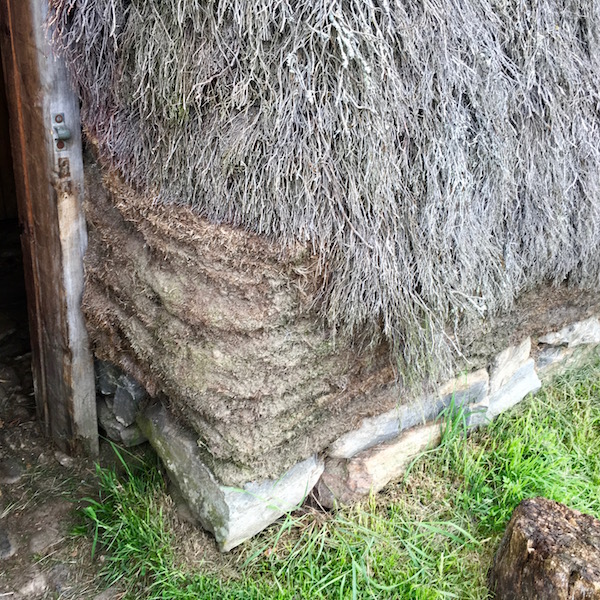
Photo G
Cottages were typically divided into thirds: one third for livestock, a middle third for living, and a final third reserved for healing, birth, and death – the so-called patch, batch and dispatch area!
The middle living space was compact, dirt-floored, and dim. Furnishings were sparse being limited to plain wooden chairs and tables. A small, peat fire burned in a central rock-lined pit. The pungent smoky air was somewhat relieved by a roof hole to admit rising peat smoke and a little light (Photo H).
SORT OF SPOILER: Skip if you must. Book readers ken that Diana writes about peat fires and cramped living quarters. This quote from Dragonfly in Amber explains living conditions from Claire’s point of view but doesn’t give away plot details:
…While I had been raised under conditions that would strike most people of my time as primitive—often living in tents and mud houses on Uncle Lamb’s field expeditions—still, I wasn’t used to living crowded cheek by jowl with numbers of other people, as was customary here. People ate, slept, and frequently copulated, crammed into tiny, stifling cottages, lit and warmed by smoky peat fires. The only thing they didn’t do together was bathe—largely because they didn’t bathe.
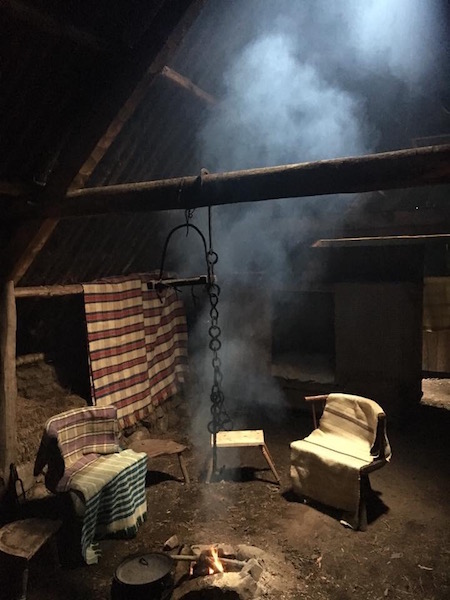
Photo H (Photo by Jonathan Giacalone – John and his wife, Maria, were tour members)
The living area also included a small wooden box bed in which families slept seated upright (Photo I). Yes, you read it correctly! Three to four people shared these cramped frames, a far cry from our king-sized, every-kind-of-imaginable-mattress beds! Why in the world did they sleep this way? Well, for two reasons: they slept upright to ease breathing because the constant peat smoke caused lung disease. They slept in multiples to keep warm which also explains the presence of livestock inside human dwellings; the animals produced a good deal of body heat. Talk about reuse, recycle, and repurpose!
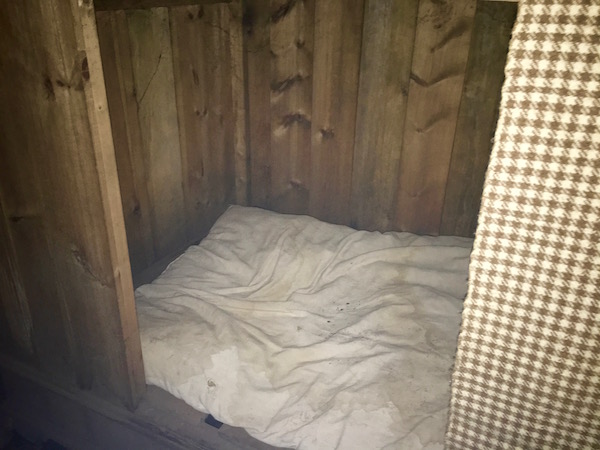
Photo I
Difficult to see inside the dim “patch, batch, and dispatch” area, but the only furnishing was a primitive birthing chair (Photo J – red arrow). Women sat up-right on this stool to deliver a child, historically a preferable position because gravity assists delivery.
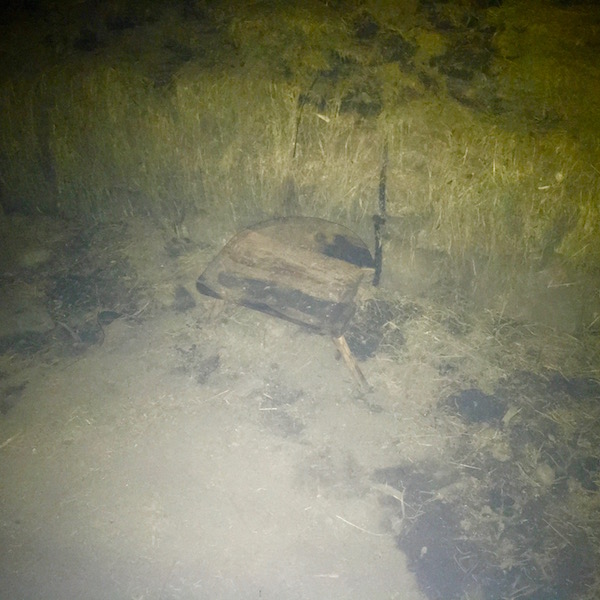
Photo J
Outside the cottage stood this knowledgeable interpreter and expert weaver. She kindly and patiently answered questions and responded to comments with droll humor (Photo K). Also, this shot provides a nice close-up view of those early tools leaning against the cottage thatch.
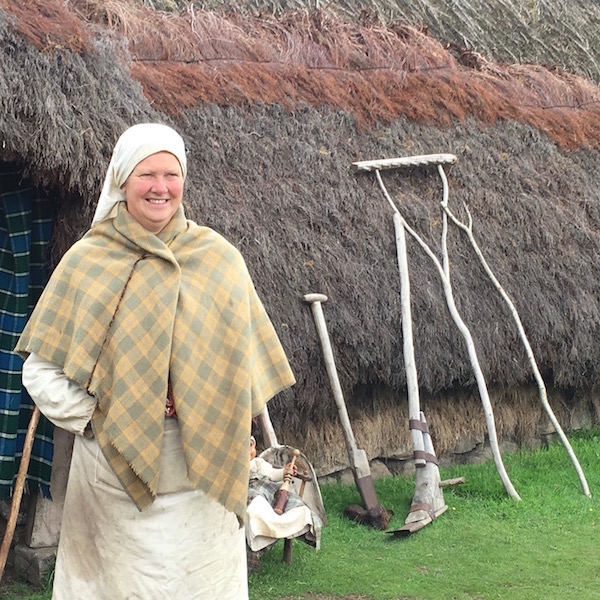
Photo K
I was completely charmed by a pair of gorgeous Scots dumpies (Photo L) who responded to the weaver’s call for corn. An ancient breed some 700 years old, Diana includes them in the storyline of her eighth book, Written in My Own Heart’s Blood.
Dumpies carry a recessive gene that results in some offspring with very short legs and hence the name, dumpy. The regal cock was called Eric – the hen went by a somewhat less elegant name, something ignoble, like gimpy. Puir gal. I am happy to say she got her fair share of the ground corn!
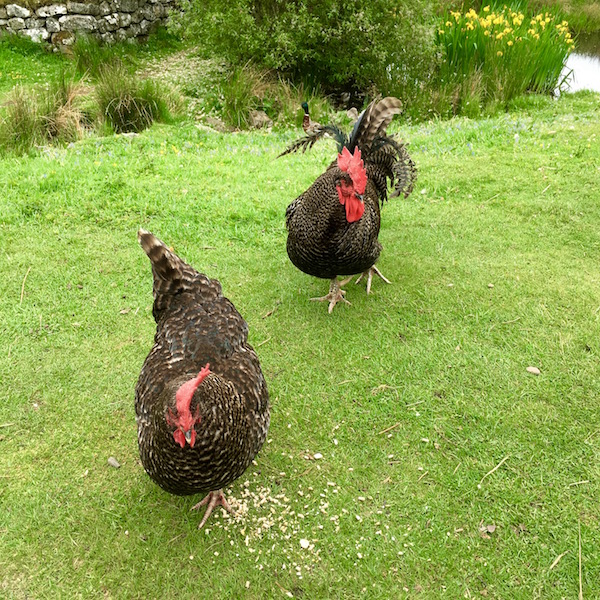
Photo L
Corn? Someone say corn? Corn reminds me of the delightful and bawdy ditty Jamie and the men chanted while traveling the rent-road (Starz episode 105, Rent)! The so-called Miller’s Song, these are the first two stanzas and, yes, it is indeed from the 18th century. The words remind me of Chaucer:
The maid gaed tae the mill by nicht,
Hech hey sae wanton
The maid gaed tae the mill by nicht,
Hech hey sae wanton she,
She swore by moon and stars sae bricht that she would get her corn grund
She would get her corn grund, meal and multure freeOot then cam the miller’s man,
Hech hey sae wanton
Oot then cam the miller’s man,
Hech hey sae wanton he
He swore he’d do the best he can for tae get her corn grund,
For tae get her corn grund, meal and multure free
Word Translations:
gaed: go
nicht: night
hech: expression of disgust (Jamie and the Rent lads don’t seem all that disgusted)
bricht: bright
oot: out
grund: ground
multure: measure of meal paid to the miller as part of his fee
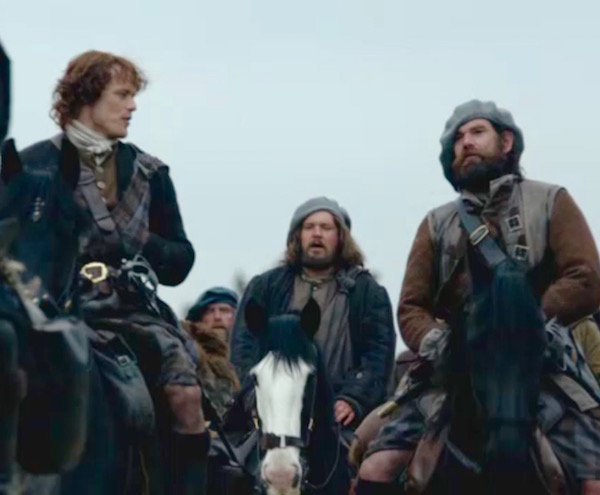
Although the angle is shifted to the right and the view more expansive, the Rent scene below was shot in the same area as Photo F. Here, Ned Gowan crossly receives two fat pigs and one fine goat as tribute to the Laird (Starz episode 105, Rent). A bored Claire gloomily sits on bags of grain as Jamie helps load goods into the wagon. The stone walls stand at middle left but I don’t spy Eric!
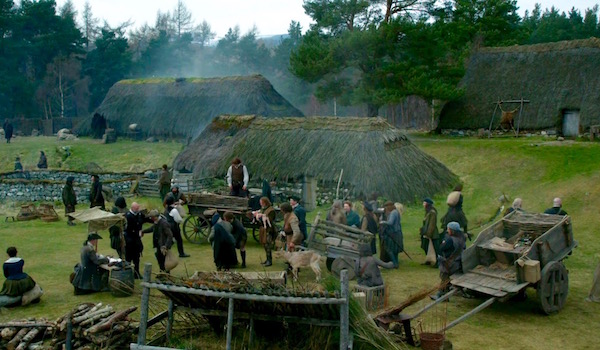
Bored Claire takes a walk and I did too! Moving a little uphill, I am standing almost exactly where Amanda Gillquist takes Claire to meet the women waulking (working) wool (Photo M). The grassy mound at mid-right appears directly behind the women in the rent image below.
SORT OF SPOILER! Again, if you don’t want to read anything from later books, please skip this next quote which explains waulking wool – from Diana’s 7th book, An Echo in the Bone. Mum about who is the “he” of the quote.
So he explained what waulking was: “The women all working together, pushing and pulling and kneading the wet wool cloth to make it tight and waterproof…”
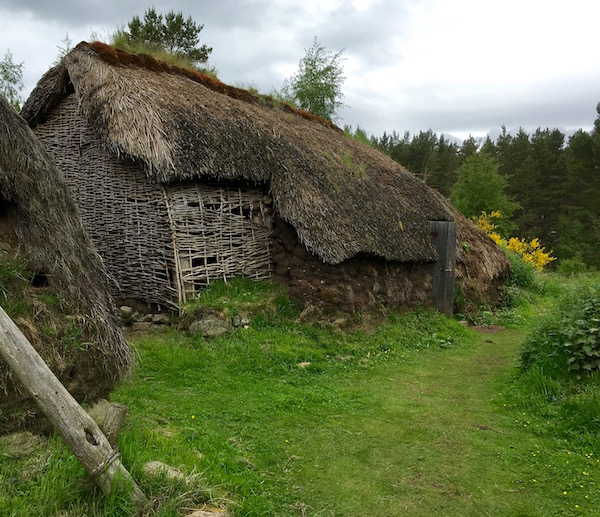
Photo M
Like Dougal’s men, the womenfolk don’t trust Claire. But, add some hot piss mixed with a wee bit of folk song and they are BFF. OK, a potent cup of “our little secret so don’t-tell-the-menfolk” ale also waulks wonders! Hee, hee.
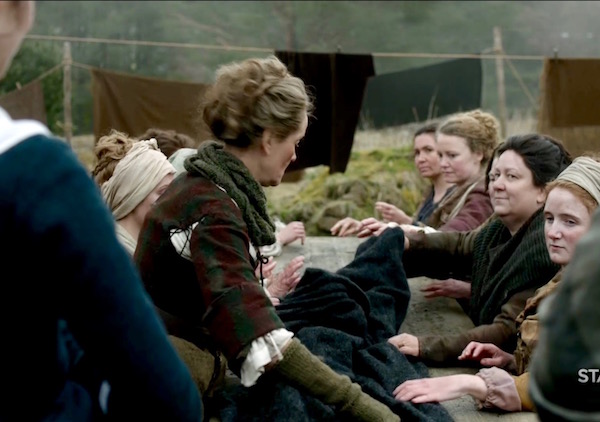
One very elegant cottage housed a loom and large gathering area. Beautifully maintained, the thatched roof is neatly trimmed and the interior sports massive wooden beams (Photo N). I was taken with the neat and tidy sod walls.
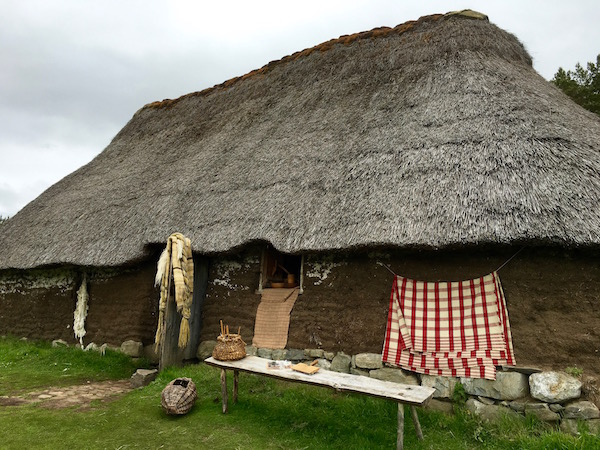
Photo N
The interior of this cottage was purportedly used for the infamous “Dougal-strips-Jamie” scene of Starz, episode 105, Rent. Mayhap this is the moment when Murtagh decides that Dougal needs killin’ sooner rather than later! Dougal was one proper dobber in this scene. Actually, this just gives us another chance to oogle Jamie’s manly chest (Anatomy Lesson #4, “Jamie’s Chest” or “The 8th wonder of the world!”). Whew, that anatomy lesson was written looong ago!
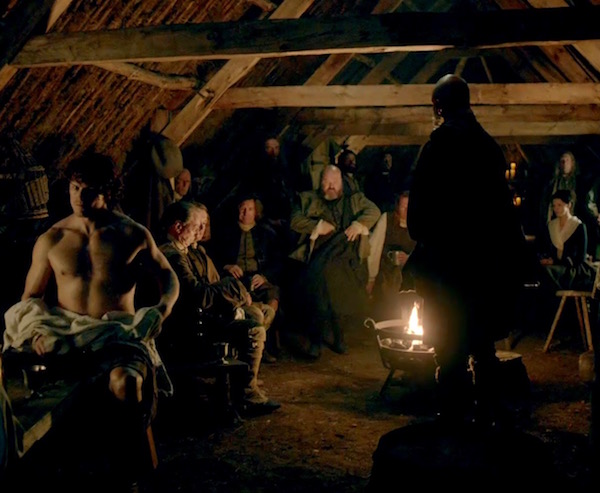
The village also includes a stable, the site where Lieutenant Jeremy Foster, in disguise, offers Claire his gentlemanly aid. May I assist you, madam? Feisty Angus snarls for Jeremy to butt out and head home to his mam’s paps. No one delivers insults better than Angus (Anatomy Lesson #41, The Sad Demise of Angus Mhor). We miss ye, too, lad!
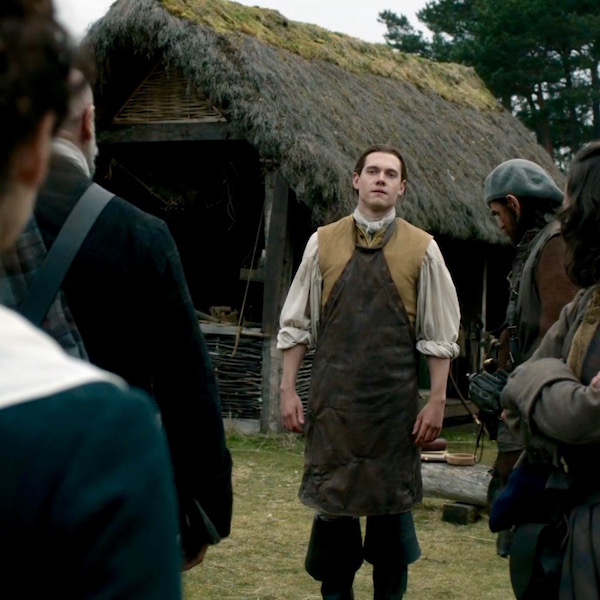
Much later, we reunite with a wounded Lieutenant Foster on the Prestonpan battlefield. Dougal praises Jeremy as the only honorable redcoat of Lord Thomas’s staff. Unwisely, the Lieutenant utters a couple of put-Dougal-down comments about the awesomeness of the British army coupled with a war chief should know that and, bingo: Dougal skewers Jeremy with his dirk (Starz episode 210, Prestonpans)! Dougal has a major problem with impulse control. Needs some anger management classes, ASAP!
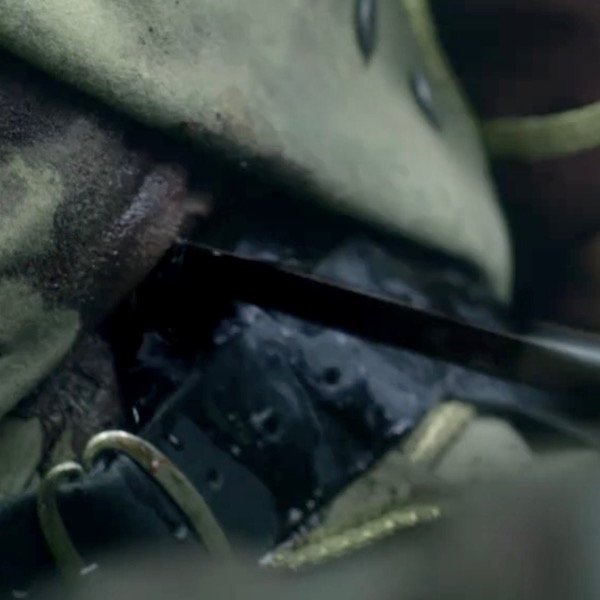
Leaving the thatched village with renewed memories of past Outlander episodes, we headed for Culloden Moor. Along the way, Highland hills were dotted with numerous small white flowers on thin stalks. Our tour guide, Hugh, explained: the flowers are actually seed heads of bog cotton. Close up, the head is a tuft of fluff that is wonderfully soft and silky (Photo O). In earlier times the silk was used to stuff pillows; 18th century mams sent restless children outdoors to keep them occupied by picking a sackful. The tufts were also used as candlewicks, for paper making, and for wound dressing during World War I.
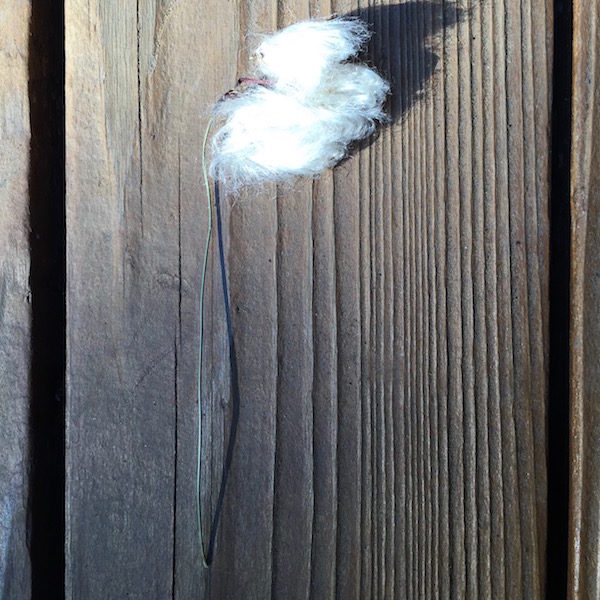
Photo O
Moving along a small highway, the Highlands displayed marvelous and varied shades of green. We passed numerous stands of mixed forest, supporting both native and foreign species. There are planted stands of Douglas-fir trees (not really firs), native to my area of the globe. Interestingly, both the common and scientific names for Douglas firs were bestowed in honor of a pair of rival Scottish botanists (David Douglas and Archibald Menzies). Aye, it is true!
I was especially taken with the Scots pine, a native conifer of Caledonia forests. This tree has a flat but rounded top unlike our PNW varieties all of which are tapered. These are the dark green trees in the foreground of Photo P. Hugh called them Caledonian pines.
SORT OF SPOILER! Yes, another quote but this one also doesn’t reveal any plot info. The trees reminded me of Claire’s own poignant description of a Highland forest from Outlander book:
The grove was dark, but not still. The pines roared softly to themselves, millions of needles scouring in the wind. Very ancient trees, pines, and eerie in the gloom. Gymnosperms, cone-bearers, winged-seed scatterers, older and sterner by far than the soft-leaved, frail-limbed oaks and aspens.
Diana paints with words, an artist of language!
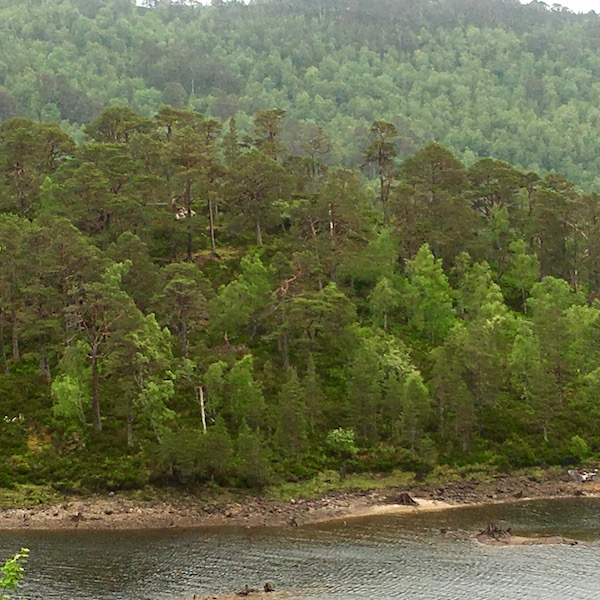
Photo P
Soon, we arrived at Culloden Moor Visitor’s Center, a beautiful, sleek modern building seated on the open moor. Just looking at the building brought tears to my eyes (Anatomy Lesson #29, “The Eyes Have It” or “the Eyes – Part One.”) and a lump in my throat (Photo Q).
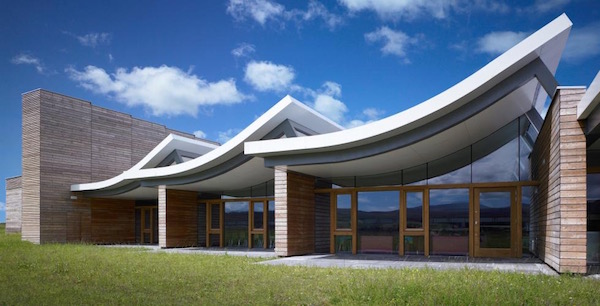
Photo Q
The walkway to the Center is made of plaques engraved with names of supporters. Near the entrance is this wonderful tribute to Diana Gabaldon (photo R) from her long time fan group, The Ladies of Lallybroch. A splendid idea, ladies!
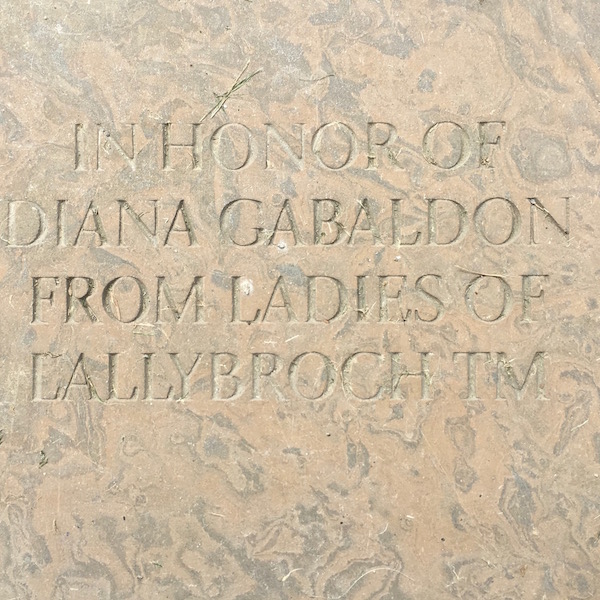
Photo R
The Visitor’s Center was filled with facts and artifacts but I was most impressed with a simple, bare-square room. Visitors quietly filled the room and then the lights dimmed leaving us in total darkness. We waited quietly and then slowly the walls came alive with projections of Jacobites and redcoats before, during, and after the battle. Watching the battle unfold in this manner complete with surround sound was more than moving. The effect was immediate and visceral; as if we were time voyagers, witnesses to the carnage! One Highlander was shot in the eye causing me to recall Rupert’s unfortunate injury (Starz, episode 212, The Hail Mary). There was really no way to photograph events in the square room. Not only was I was too overwhelmed to even think about it, events were unfolding on all four walls at once. No way to capture such an immersing experience!
This plaque from outside the Visitor’s Center shows the Jacobite line (blue flags) facing the redcoat line (red flags). Clearly, the lines are not parallel, a fact contributing to the Jacobite’s defeat (Photo S). More about this in the next post.
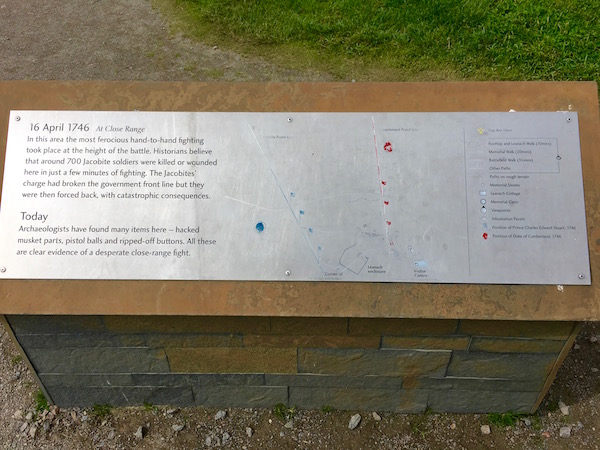
Photo S
Let’s end with all things, Diana! One of her latest activities is to lend her gravitas to preserve and protect both Culloden and Rannoch Moor (Photo T). You can read the full article about her commitment at The Press and Journal.
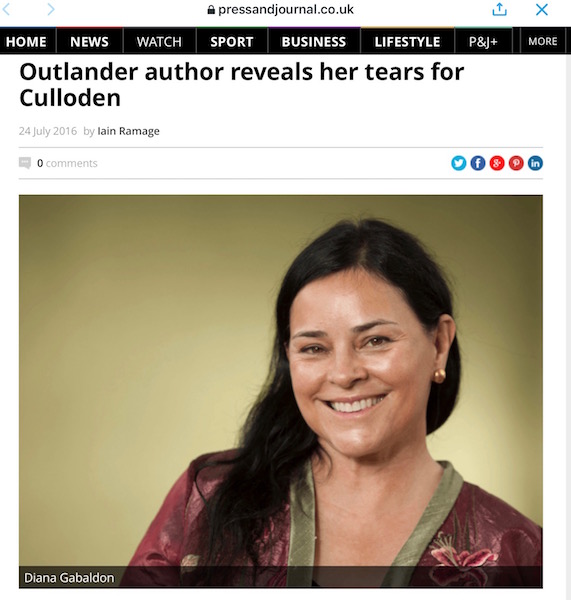
Photo T
A deeply grateful,
Outlander Anatomist
Photo creds: Starz, Outlander Anatomy, Jonathan Giacalone (Photo H), www.highlifehighland.com (Photo D), www.pressandjournal.com (Photo T), www.rias.org.uk (Photo Q)

